A Couple of Articles from a Recent Issue of The Ark
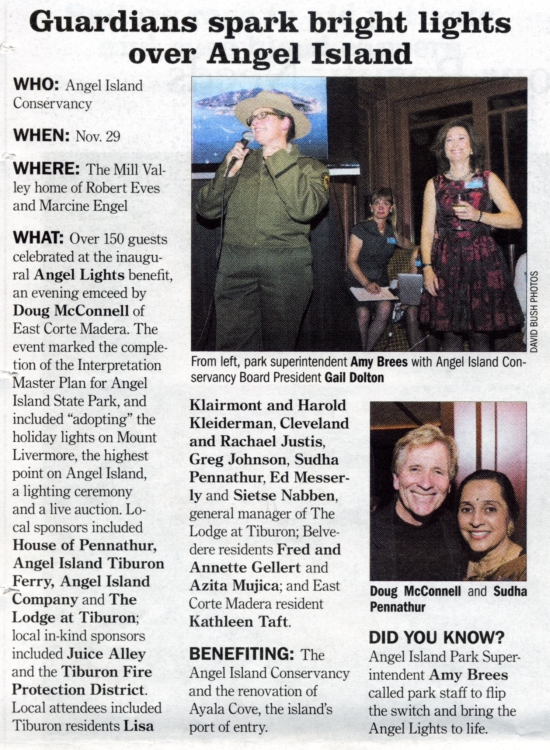
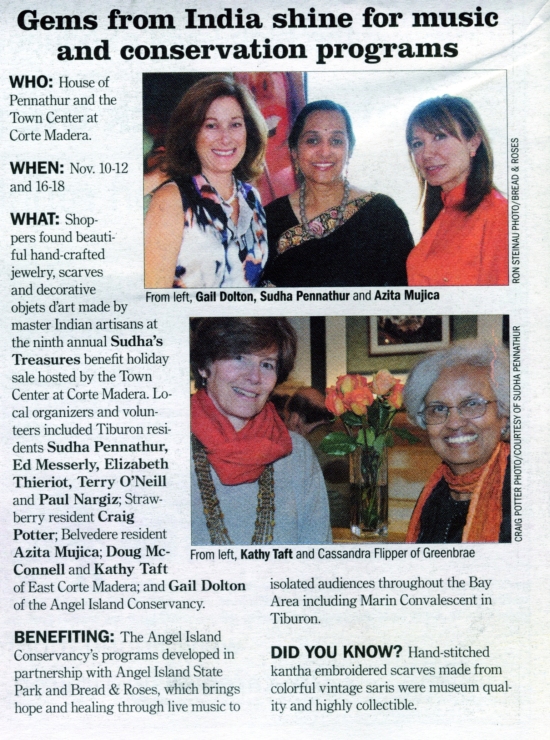
A Couple of Articles from a Recent Issue of The Ark Read More »
Click HERE to go to Marin Scope Article
Precious stones: Susan Spielman (left) and Aimee Brown alongside Pennathur, wearing some of her finest jewelry. Brown is wearing Pennathur’s “coffee bean” diamond necklace. The necklace is made of thousands of black diamonds and costs upwards of $30,000. Gregory Andersen/Marinscope.
Posted: Wednesday, November 14, 2012 12:46 pm | Updated: 3:27 pm, Wed Nov 14, 2012.
By Gregory Andersen | 0 comments
World-renowned entrepreneur and designer Sudha Pennathur’s keen eye for fashion may only be exceeded by her genuine, heart-warming personality. For Pennathur, the purpose of her product line is neither for profits nor fame. It’s sustainability.
Each year, the Indian-born businesswoman-turned-fashionista returns to her native country to work with an elite group of craftspeople who assist in inspiring and designing her products. Upon returning to the U.S., she sells the crafts and reinvests much of the profits back into the lives of the Indian craftspeople.
Pennathur said her charitable donations embody the thought behind both her fashion line and her business approach.
“I think I wouldn’t be where I am if it wasn’t for my community,” Pennathur said. “It’s an unbeatable combination – East meets West. Ultimately, it’s just one large world we live in, and we need to benefit each other in everything we do.”
Pennathur grew up in India, attending school in New Delhi and college in Bombay. She moved to the U.S. and earned her master’s degree in business at the University of Washington before beginning a career at Levi Strauss.
After working her way up through the business side of the fashion world, Pennathur left Levi Strauss and returned to India.
“I wanted to see what I could do from India in terms of artisans,” Pennathur said.
Each year, India selects 10 awardees who have excelled in their respective crafts, be it silversmithing, textile weaving or embroidering. Pennathur began working with these national-award winners, selling their creations to high-end retail stores, museums and household consumers.
Part of the money she reinvests into the Indian craftspeople is for education. The children of the craftspeople are now able to afford schooling and are able to expand their families’ business. According to Pennathur, she is currently working with the third generation of artisans.
But the beneficiaries of Pennathur’s generosity are not limited to India.
For the past nine years, Pennathur has hosted her annual Sudha Sale to benefit Bread & Roses, a Marin County charity. She has also worked with The Redwoods and other Marin organizations.
This year, the Sudha Sale has set up shop at the Town Center Corte Madera to benefit Bread & Roses and Angel Island Conservancy, a group dedicated to revitalizing Angel Island State Park.
Last weekend, the first of the Sudha Sale’s two scheduled weekends, Marin residents flocked to get a glimpse of Pennathur’s latest fashions. This year’s sale features a special selection of holiday décor for Christmas and Hanukkah.
The Sudha Sale will be open for the second straight weekend, beginning Nov. 17. Hours are Saturday, 10 a.m.-6 p.m.; and Sunday, 11 a.m.-6 p.m. For more information on the Sudha Sale, visit pennathur.com.
Contact Gregory Andersen at gandersen@marinscope.com.
Marin Scope: Sudha Sale Sustains – Benefits Bread & Roses Read More »
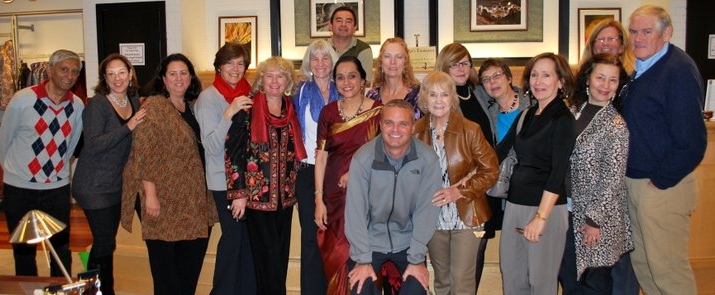
As evening settled over the Corte Madera Town Center, the Ninth Annual “Sudha Sale” got off to a fine start on Friday, November 9 with crowds of expectant shoppers entering a world of Sudha Pennathur’s imagination. The old Ann Taylor store had been re-imagined as a colorful, jewel-toned gallery selling artisanal goods from India and the Far East, all designed by Sudha and crafted by her team of hundreds of artisans. Playful kantha scarves held their own; finely-woven pashminas and gem-encrusted necklaces contrasted with costume pieces; colorful skirts and jackets anchored one side of the room while whimsical bags, holiday ornaments, and decorative items highlighted the other. A buffet of pizza, ceviche, brownies and drinks kept energy high as shoppers took in the scene.

The highlight of all, of course, was the fact that all profits from the sale of these goods would benefit Bread and Roses and Angel Island Conservancy, two local non-profits supported wholeheartedly by Sudha for many years. With the room full and buzzing, Doug McConnell introduced Sudha in a short talk that underscored her great commitment  to her community over the years and the grace with which she manages it all. Sudha followed, to speak of her long appreciation for Bread and Roses and the remarkable work it does all year and and for the historic and natural significance of Angel Island She also thanked the dedicated volunteers and staff from both organizations who had helped set up the sale and are critical, day in and day out, to the continued success of these groups.
to her community over the years and the grace with which she manages it all. Sudha followed, to speak of her long appreciation for Bread and Roses and the remarkable work it does all year and and for the historic and natural significance of Angel Island She also thanked the dedicated volunteers and staff from both organizations who had helped set up the sale and are critical, day in and day out, to the continued success of these groups.



Sudha Treasures Benefit Sale opens November 9th in the Town Center Read More »
|
from the…
Bread & Roses Key Notes, Issue 71
FALL NEWSLETTER
|

Ninth Annual Sudha Sale to Benefit Bread & Roses The Ninth Annual Sudha Sale — benefiting both Bread & Rosesand The Angel Island Conservancy — will be held at the Corte Madera Town Center November 9 -11 & 16 – 18. The sale will feature hand-crafted scarves, clothing, jewelry, holiday ornaments and home décor from the collection of acclaimed designer Sudha Pennathur whose work is sold throughout the world in prestigious stores, museum shops and catalogs.
With wholesale prices for shoppers, Sudha Sale Hours are: Fri. Nov. 16 from 10 am-5 pm, Saturdays, Nov. 10 & 17 from 10am-6pm & Sundays, Nov. 11 & 18 from 11am-6pm. For sale updates, visit Bread & Roses and for information on Sudha Pennathur’s work and designs, visit her website. Photo: Designer Sudha Pennathur with some of her creations for this year’s Sudha Sale. Photo Collage Courtesy Sudha Pennathur, Photo of Sudha by Usha Kris
|
From the Bread & Roses Fall Newsletter: Read More »
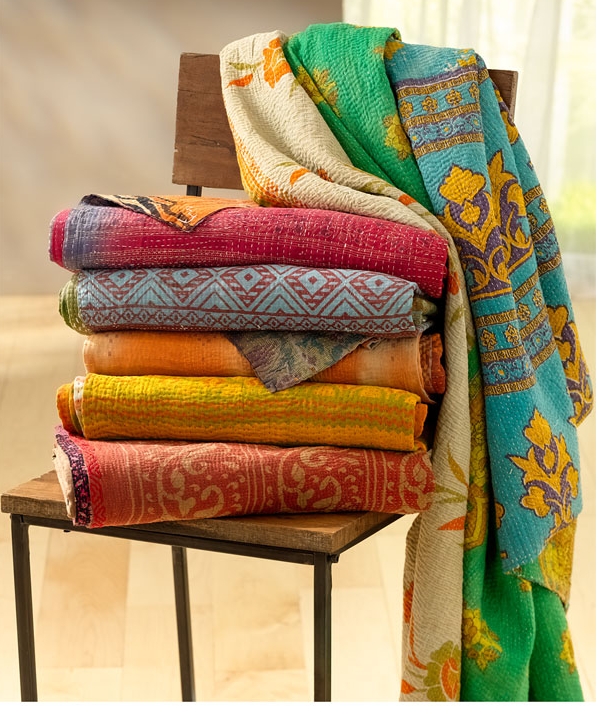
What is unique about this technique from West Bengal is that long before sustainability was a buzz word, the women in Calcutta region would embroider on old cotton saris and recycle them for homes. Many of the saries were so well worn they would be patched together and that would lend an air of authenticity.
To create these works of art, women would gather multiple layers of assorted cotton saris and sew them together. Then with weights placed on each corner to stretch the fabric, the women do a running stitch through the many layers. The stitches often are interspersed with alternating long and short stitches. Often the threads for the embroidery are drawn out of the edges of the saris! Because the saris have been worn for long and washed repeatedly, the colors are often muted and to our modern eye look sophisticated. Since it is as lovely from either side, it is reversible!
Each woman uses her imagination to do the quilting. Every piece thus becomes one of a kind.
The works of these village women is carefully brought to the West by Sudha and is now available at select stores and on the web.
Kantha Embroidery as Throws Read More »
 When we think about the word “sustainability” today, we generally understand it connoted to mean something ecologically friendly. However often forgotten is the social aspect that comes with the principles of sustainability. Sudha’s designs not only embody this ecologically aware notion of the word but also reach one step further into the realm of social sustainability. Each of her designs is carefully hand crafted by artisans in India. Sudha works directly with these master craftsmen to take the crafts that have been passed down in their family for generations and adapt them to creating works of art for American consumers.
When we think about the word “sustainability” today, we generally understand it connoted to mean something ecologically friendly. However often forgotten is the social aspect that comes with the principles of sustainability. Sudha’s designs not only embody this ecologically aware notion of the word but also reach one step further into the realm of social sustainability. Each of her designs is carefully hand crafted by artisans in India. Sudha works directly with these master craftsmen to take the crafts that have been passed down in their family for generations and adapt them to creating works of art for American consumers.
 Thus when an American woman steps into Bergdorf Goodman to purchase one of Sudha’s exquisitely hand embroidered zardozzi tree skirts, an ornament from Saks Fifth Avenue or an Indigo dyed, hand block printed duvet cover from The National Geographic catalog, she not only purchases a work of art, but she is recognizing that these items have been especially and uniquely crafted by some artisan and that by purchasing it she is helping support them and their families. House of Pennathur forges these global connections by delving into markets that would otherwise remain untapped in an increasingly technological world. Rather than distancing the consumer from the production process of her works, Sudha strives to imbue each work with the meaning, feeling, and warmth of human connection.
Thus when an American woman steps into Bergdorf Goodman to purchase one of Sudha’s exquisitely hand embroidered zardozzi tree skirts, an ornament from Saks Fifth Avenue or an Indigo dyed, hand block printed duvet cover from The National Geographic catalog, she not only purchases a work of art, but she is recognizing that these items have been especially and uniquely crafted by some artisan and that by purchasing it she is helping support them and their families. House of Pennathur forges these global connections by delving into markets that would otherwise remain untapped in an increasingly technological world. Rather than distancing the consumer from the production process of her works, Sudha strives to imbue each work with the meaning, feeling, and warmth of human connection.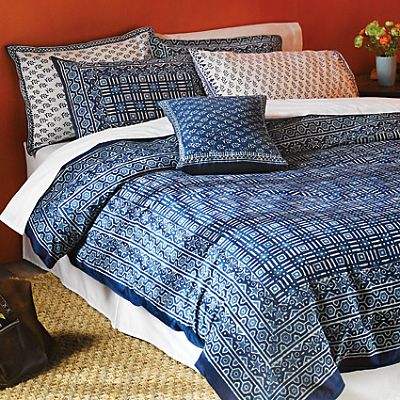
Social Sustainability Read More »

The technological boom of the past two decades has led us into a feeling of hyper-connectedness with the outside world; yet, largely unacknowledged is the percentage of the world’s population who cannot be merely reached by the

simple click of a mouse. In an increasingly de-personalized world, House of Pennathur strives to reach these individuals and incorporate them into a larger global economy, to aid them and their families and truly sustain them by rekindling the passion for artisanal crafts in India.
Highly labor intensive these crafts are the life blood of the folks in India
For an example of the Gudri work featured at Nordstrom click here
Products That Sustain Society Read More »
From the April 2012 Marin magazine. Sudha with Diana Adachi and many of the other guests of the Diamonds in the Sky event at Elisabeth Thieriot’s.
Please see our new Kashmiri Mineral Box at Smithsonian and also in the Spring 2012 catalog.
Description from Smithsonian:
“This tiny treasures Kashmiri Mineral Box showcases the centuries-old craft of Kashmiri wirework. Adorned with floral granulations, the gemstone inlays showcase carnelian and aventurine. 1″h. x 4.2″l. x 3.25″d.
Imagine yourself a traveler in Africa or Asia. Awed by the sights, you wander through the local shops, searching for something special to bring home to represent the cultures you’ve seen. Shop our mini world market and delight in these artisan offerings from Africa and India. Each of these lovely treasures is representative of holdings in our National Museums of African Art and Natural History.“
Smithsonian Spring 2012 Read More »
Chikan is the traditional white-on-white embroidery of Lucknow in northern India. Artists start by block-printing a design onto the fabric, which they trace using a variety of stitches to create a textured, lacy pattern. This semisheer, short-sleeve blouse features chikan work (chikankari, which literally means “embroidery” in the Urdu language) covering the front, along with a squared neckline and side vents.
Women’s sizes S (4–6), M (8–10), L (12–14), XL (16–18).
New Chikan Shirt at National Geographic Read More »